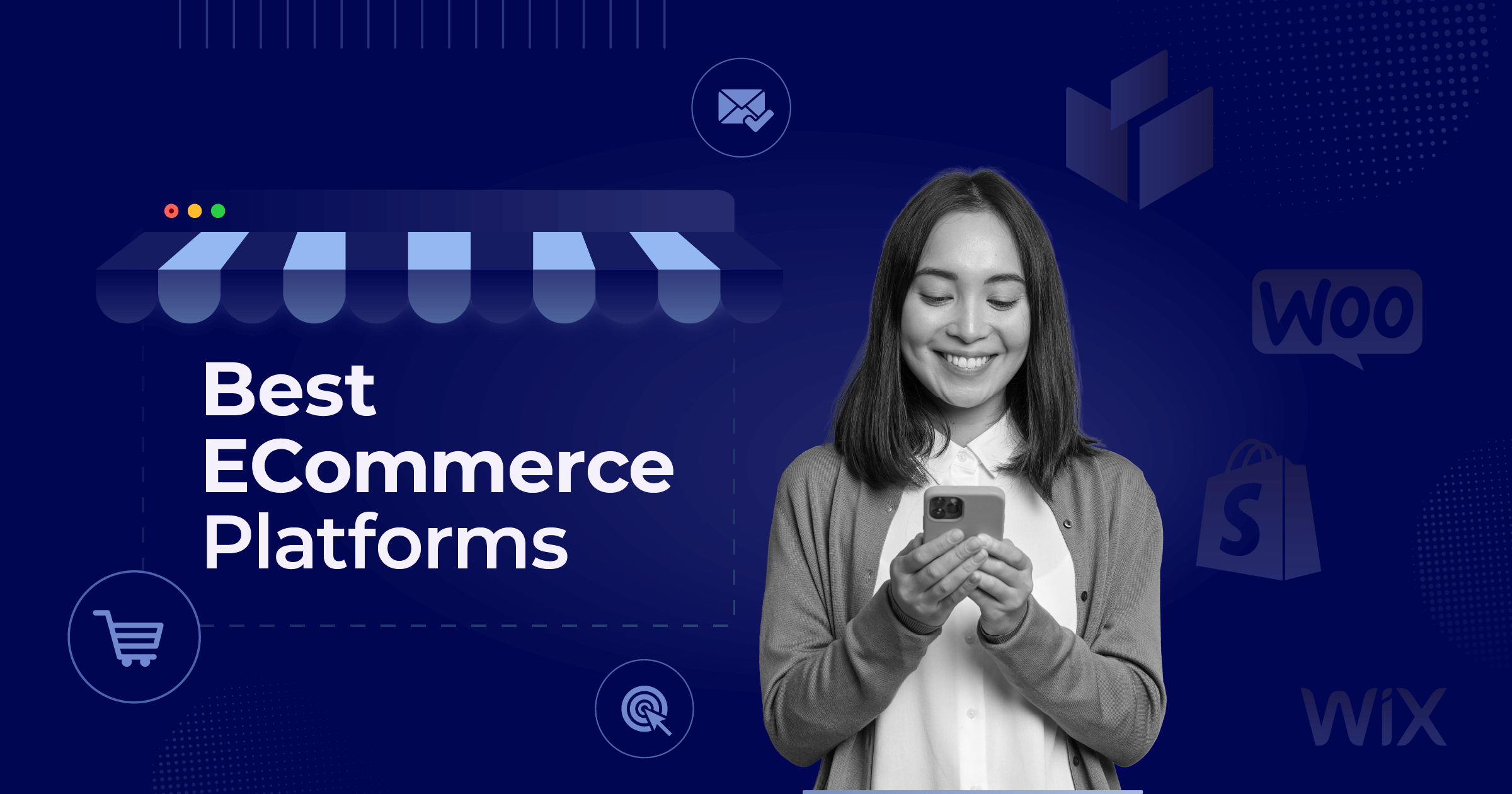
E-commerce Referral Programs: Ultimate Guide [2025]
Many of us know what referral marketing is and how it works. There’s a good chance you’ve participated in a referral/’refer a friend’ campaign by recommending a friend, family member, or colleague to a brand and product you love.
In today’s digital world, customer acquisition costs (CAC) are rising across the board for many major marketing channels, especially paid advertising. In fact, it’s risen by 222% in the past 8 years alone. So brands need to start becoming smarter when it comes to maximizing customer lifetime value.
This is where implementing relevant initiatives, such as eCommerce referral programs, comes into fruition to help brands generate more customer revenue and ultimately maintain a healthy CAC: LTV ratio. Let’s learn more about this marketing tool and how to use it successfully.
Referral Marketing Program Benefits
So why is referral marketing, in particular, an important strategy for brands and what are its benefits? Let’s have a look:
- Reduce your cost per acquisition: Referral programs can also help with advertising efforts.
- Improve customer retention: Referral marketing can potentially achieve a 5x increase in CLTV than other initiatives/channels.
- Encourage quality customer signups: Acquiring customers who stay and spend more over time (i.e. make multiple purchases or subscribe to a plan), is going to help with the compound growth of your business.
- Increase word-of-mouth marketing: The more people refer their friends, the more people hear about your brand from various online sources/mediums.
- Easy setup and low maintenance: Major eCommerce CMS, such as Shopify or BigCommerce, make the integration process seamless and easy to maintain.
Harry’s eCommerce Referral Program Example
So, the benefits are clear, but what does a top referral program look like from a brand that’s implemented such a system in terms of results and effectiveness? Let’s see an example.
Harry’s had one of the most successful referral-based programs, where they managed to gain over 100k+ emails in one week. The folks at Viral Loops created this awesome replica example of what the process looked like.
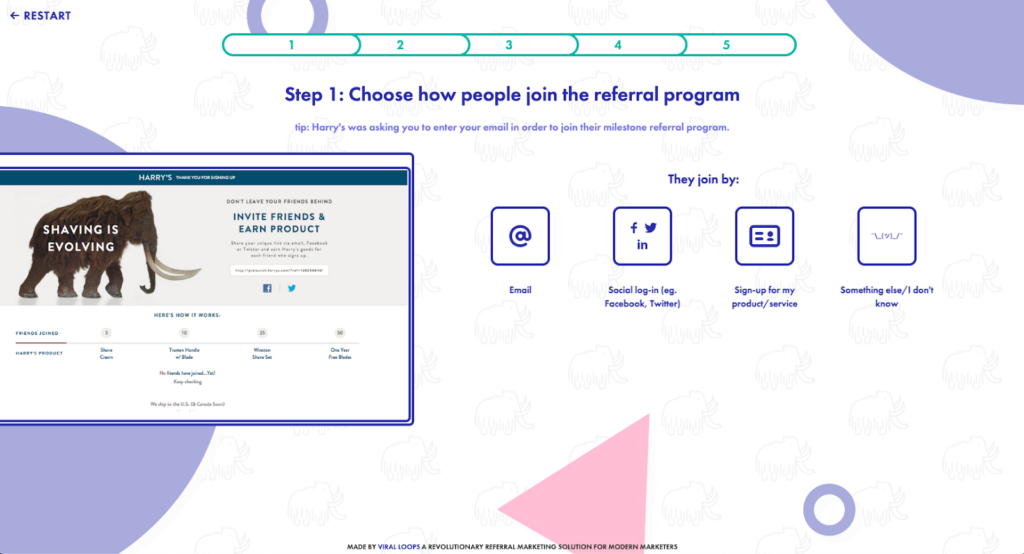
So, now that we’ve covered the benefits in terms of ROI and what a successful example looks like, let’s dive into the top strategies that go into building a referral system and program that can work for your brand.
How To Set Up A Successful Referral Program Marketing Strategy
Wondering how an eCommerce business can initiate its own referral program? Have a look:
1. Determine incentives and referral rewards
To make an eCommerce referral program successful, you should offer a compelling incentive, such as a discount or coupon code that will ultimately help convince customers to engage with it. The incentive should cost less than your ‘usual’ cost of acquisition (CAC), particularly when measured against paid channels, to encourage new visitors to become customers.
From my experience helping a few e-commerce brands, I’ve found two types of incentive structures to perform best:
Two-sided programs – Interestingly enough, over 90% of referral structures are two-sided. Two-sided systems occur when brands provide an incentive structure where both parties (the referrer and the referred customer) are rewarded.
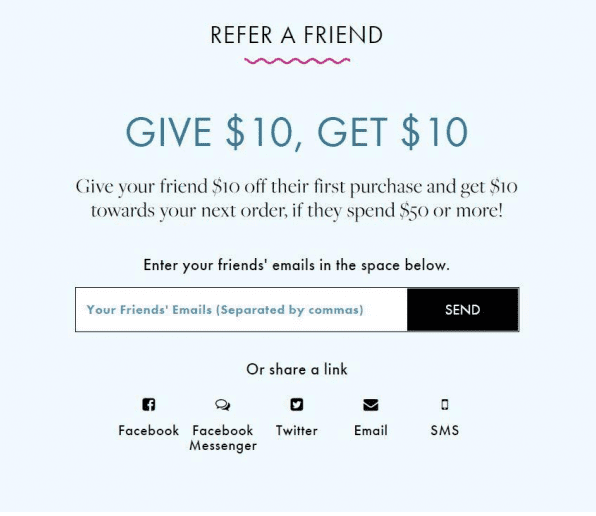
Source: Referralcandy
Multi-tiered programs – As for multi-tiered incentives, there are usually various rewards based on the amount of successful referrals you make. It’s an effective strategy as you can motivate customers/visitors to keep referring more friends and unlock more rewards over time.
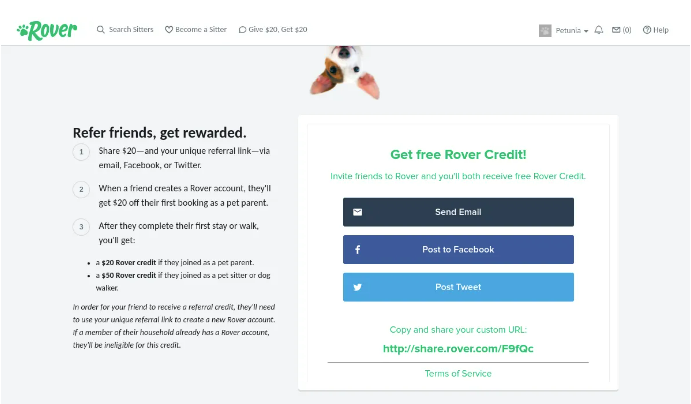
When it comes to setting up multi-tiered systems, they are a bit more complex, but the rewards from a customer engagement, acquisition, and virality perspective are amazing.
If you’re just starting out your referral program, focus on a two-sided system for now. For brands wanting to take it to the next level, it’s worth exploring what a multi-tiered structure looks like.
2. Map out the customer journey
We all know the importance of personalization in the eCommerce world, and the same stands for referral marketing. One of the more important initiatives when it comes to the set-up of a referral system is ensuring you’re prompting automation triggers at the right time of a customer’s interaction with your eCommerce store.
You can send personalized automated emails to specific customer segments. For instance:
- A customer has made multiple purchases within a given period (e.g. six months).
- A customer has left a positive review (check out the example below).
- Any customer that fits within the criteria of a certain AOV (average order value) range or total CLTV amount.
This, of course, doesn’t mean you can’t promote your customer referral program to recent customers or even to subscribers who haven’t made a purchase yet. However, people with a first-hand positive experience with your products/services are usually willing to become brand advocates.
Here’s a great referral email example from Fellow:

There are two key components of personalization adopted here:
- First, we can see the referrer’s name.
- Second, we can see the message that was sent to the referred friend.
In a nutshell, personalization in practice, just like this example, works wonders when it comes to improving your conversion rates.
3. Choose the right software
Building any sort of custom referral system is usually a challenging task. Fortunately, there are a number of amazing referral marketing software options out there that make it much easier to set up and track referrals efficiently.
However, there are too many options to choose from, with each of them having their respective strengths and weaknesses.
So here’s what you should look for in a referral software:
- It has an ‘easy’ integration with your CMS (or at least through Zapier).
- It enables you to set up two-sided and multi-tiered referral programs.
- It offers stellar analytics and performance-tracking capabilities.
- It provides users with UI design customization and branding features.
For those who are looking for specific solutions, check out:
- Friendbuy – A really nice UX/UI, used by many large brands.
- Viral Loops – A great solution for multiple types of referral campaigns.
- Gather – Awesome for more advanced customized setups and multi-tiered rewards.
4. Design captivating emails
One of the key touchpoints to boost the referral experience is email marketing. So what type of emails should you build to increase your conversion rates?
Well, you should focus on two main categories: One for the referrers to encourage current customers to sign up and invite their friends, and one for the referred friends to invite them to take up the offer.
Here are some of the top factors to incorporate into the first category:
- Personalize the subject line and body text.
- Include the steps and benefits of how the program works.
- Make the incentive clear via the subject line, headline within the email and CTA.
- Add social proof and trust badges where possible (for trust and credibility).
Then, for emails for the ‘referred’, you can include all the above elements, as well as:
- A personalized note (a great example of this is just below).
- Ideally, include the first name of the recipient, depending on your email marketing service.
Let’s check out a couple of awesome email examples. First, one of the more impressive referral programs I’ve seen in terms of setup, user experience, and design is from Cometeer.
This is certainly a top-tier example, that highlights the number of referrals a customer has made, has a clear heading and description of the offer, including the rewards someone can receive when they make ‘X’ amount of referrals.
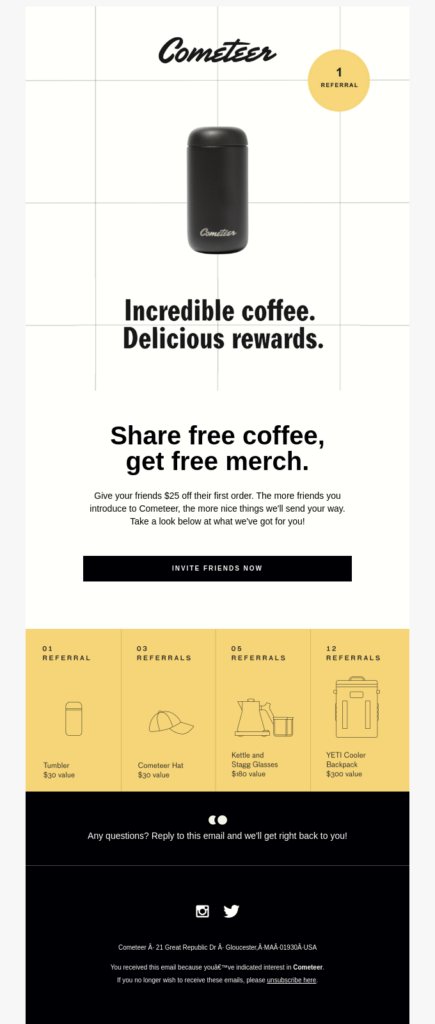
The second example is by Our Place, including a personalized note by the referrer:
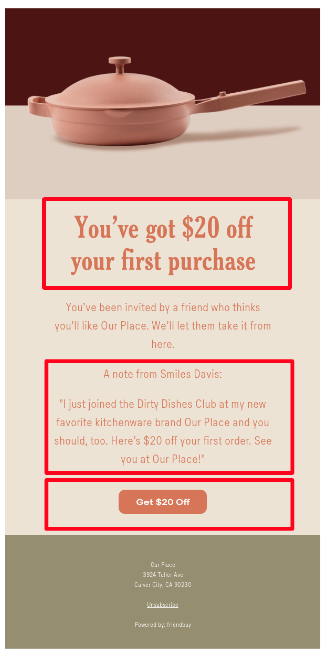
Want to create amazing referral emails in simple steps? Sign up for a free Moosend account, pick one of the ready-made templates, and customize it to elevate brand awareness.
5. Create a compelling landing page
A well-structured landing page will help you promote your referral program on your website. When it comes to designing a referral landing page that drives action and conversions, here are the key elements to incorporate:
- A clear headline and call-to-action
- Descriptive and relevant copy
- The incentives and guidelines on how to claim them
- A list of common FAQs (optional)
- Social proof testimonials (optional)
Here’s a great example from MAC Cosmetics:
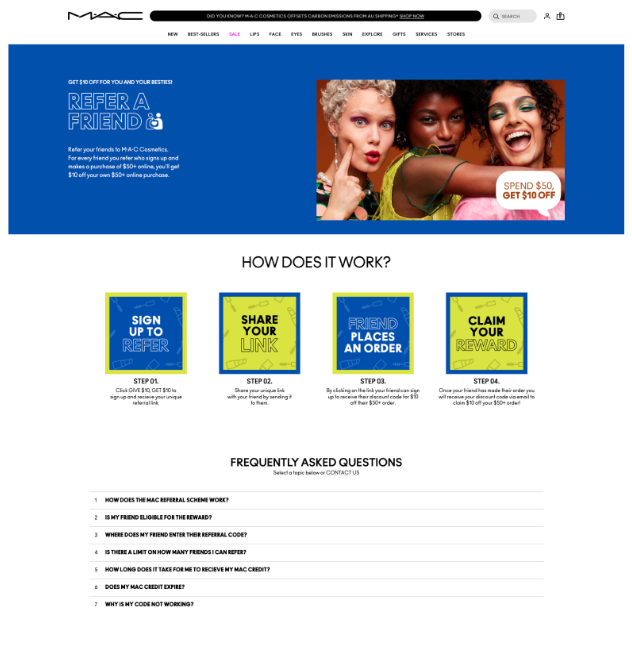
If you’re just starting out, you can create a minimal landing page from scratch and optimize it by adding more elements over time. For example, Bonobos keeps their page simple, with an embedded form above the fold.
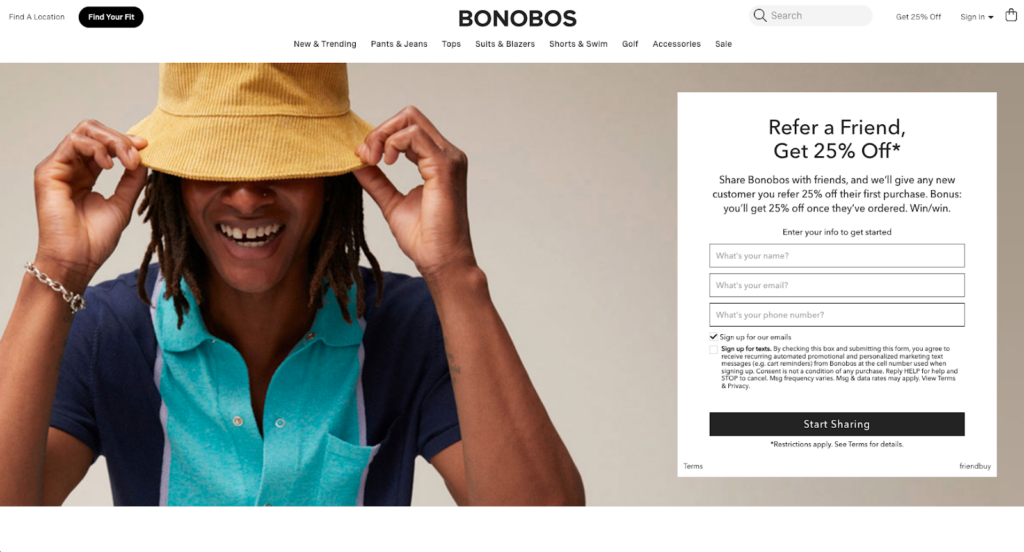
Do you need a user-friendly tool to craft your first landing pages for your referral program? Sign up for a free Moosend account and nail your eCommerce referral marketing!
5 Best Practices To Improve Your Referral Marketing Program
Now that we’ve explored the strategic steps to set up a robust eCommerce referral system, it can’t reach its full potential without a strong promotional plan in place.
Here are some top strategies I’ve implemented from my experience that have worked for brands that make referrals perform for growth.
1. Make your referral program easily accessible
What I find a lot of brands tend to do is unintentionally ‘hide’ the fact that they have a referral program, especially when it comes to online stores. If you don’t make it obvious that you run a program on the site, then most people are going to overlook it.
When it comes to the website, it’s worth adding that you have a program:
- As part of the footer
- Header navigation
- Even a sidebar pop-up/tag
Here are some examples for inspiration. First, we’ve got Life Botanics, who make their referral program page easy to find via the main navigation.

The second example is by Hanni – they added a CTA which stands out nicely compared to the rest of the page.

The third example is by Solawave, where a sidebar embedded form pops out from the left when you click the ‘referral’ program in the footer or when you press ‘Gift a friend $20 off’ through the left-hand static widget. They use a 3rd-party tool called Superaffiliate to make this happen.
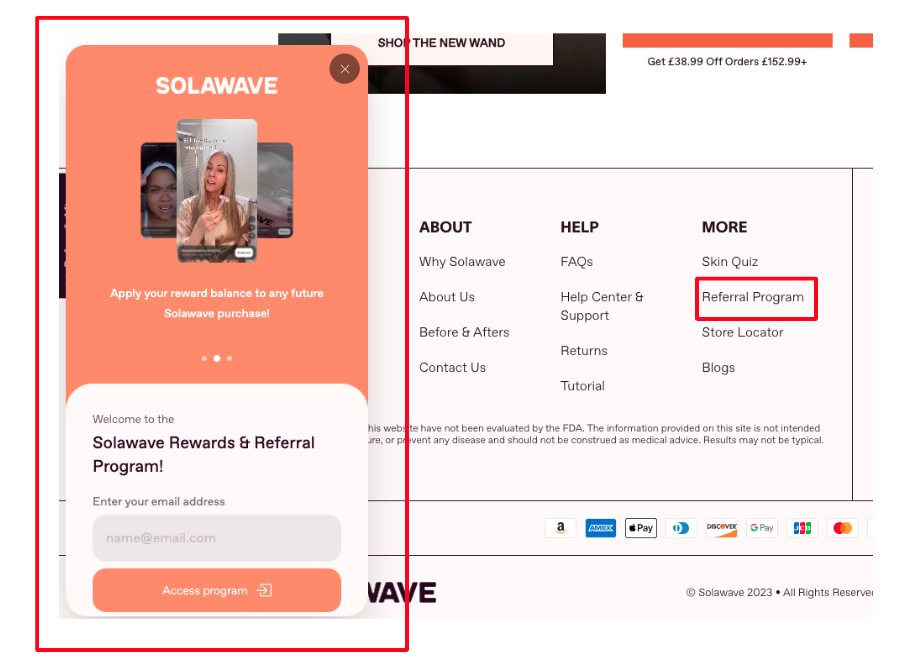

2. Explain sharing options
A key factor to making a referral system work for brands is ensuring that the ‘sharing UX’ is really slick and seamless for visitors and loyal customers. When someone opts in for a program offer, it’s best to give them some options on how to share their code or referral link with their friends.
Check out the example below:
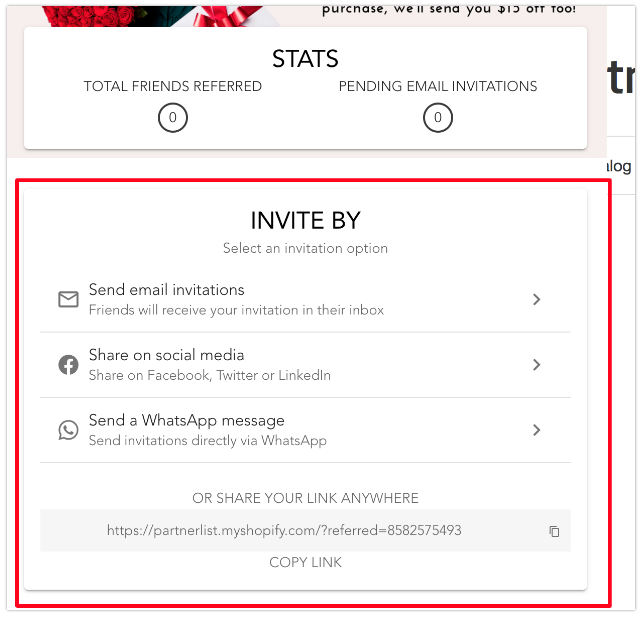
Briefly, there are ‘easy-to-use’ options to share the custom link via:
- Email invitations
- Social media channels
- WhatsApp specifically
- Copy/paste to share to other channels/social media platforms.
They’ve also displayed the ‘stats’ at the top, to remind users how many friends they referred and the pending invitations.
3. Build a customer loyalty program
Your most frequent customers are more likely to be natural advocates of your brand (via socials and chatting with friends) and engage with your “refer a friend program.” To effectively adopt this strategy, your designated CMS or customer portal should help you easily segment your lists to find top repeat purchases and the highest AOV/LTV customers.
Long story short, loyalty programs can also have referral mechanics as part of the rewards system to help drive friends to invite their friends to make purchases. Plus, incentivizing existing customers to share reward programs helps motivate them to refer their friends to get involved.
So, what’s a good example of a loyalty program that has referral incentives for customers? I’m a big fan of what Dae Hair has done (which happens to be up there as one of the best loyalty program pages I’ve seen).

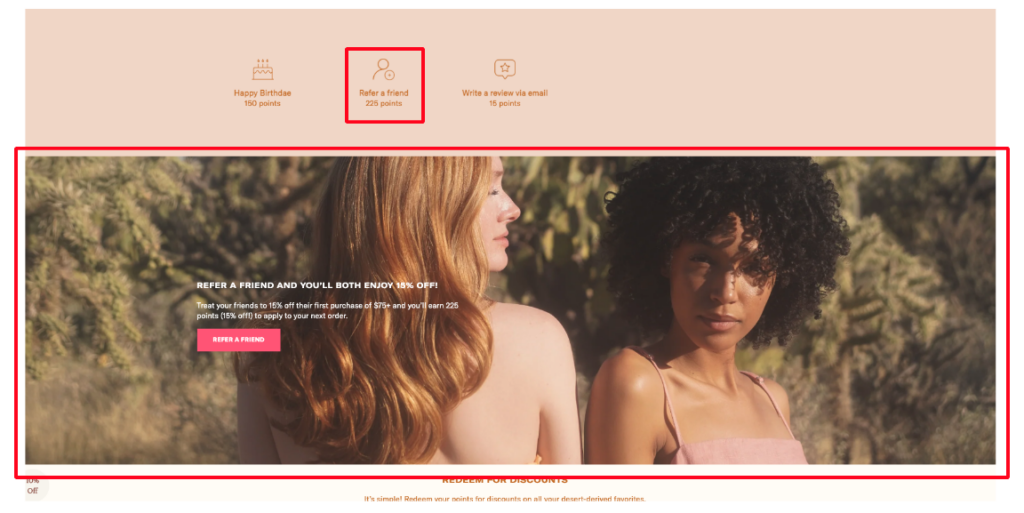
Dae Hair have highlighted within their rewards program how referring a friend works – earn 225 points per referral, where a friend receives 15% off their first purchase if they spend $75 or more.
4. Provide a post-purchase referral incentive
A strategy I’ve tested with a couple of brands lately is adding the referral option to confirmation emails. In other words, give the opportunity to happy customers who’ve just made a purchase through your site, to share a special offer to their friends.
Check out this example from MeUndies:
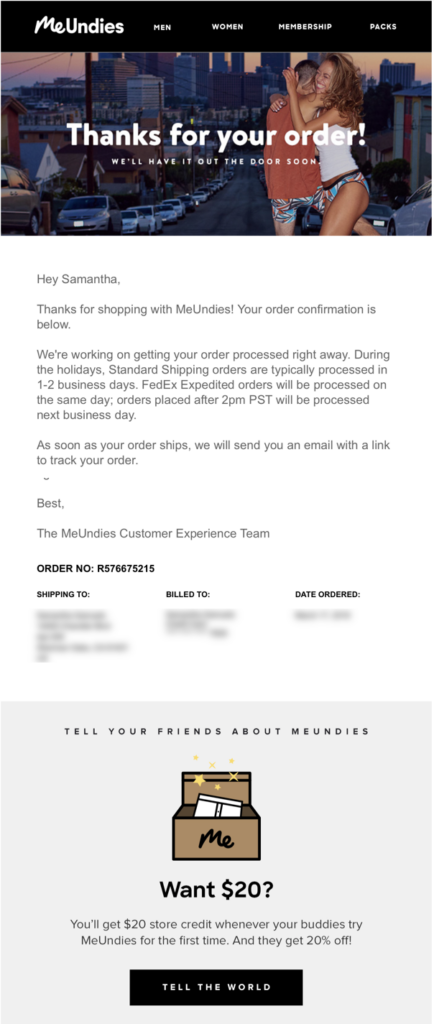
As we can see, it states the purchase information of the recipient followed by a CTA at the bottom with the clever copy “tell the world,” as well as a clear heading with the offer ($20).
Just a simple nudge like this post-purchase can go a long way to empower new customers to bring their friends over, even after their first order.
5. Run referral-focused competitions
Finally, you can run a competition where a referral system is put in place to help entrants invite their friends based on incentives – for example, the more friends you refer, the more entries you may receive, or even the chance to receive better rewards, such as gift cards or free products.
Normally, creating these types of competitions may take a lot of time and can be quite complex to build, but luckily, there are some amazing viral competition tools that make life a lot easier for brands to set up. Plus, they’re cost-effective.
One of the platforms I recommend checking out is called Vyper. They helped an e-commerce brand called Coconut Bowls generate over 40,000+ emails in just one competition, with a total budget of around $1,000. On top of that, they generated thousands of social followers and total website views. To say the least, it is a pretty epic result for such a tight budget, right?
The main takeaway here to remember is that ‘referral marketing’ doesn’t always have to be focused on a company’s ‘ongoing main program’. You can build referral-focused initiatives like competitions/giveaways, special flash weekend offers, seasonality offers (etc.), which help encourage friends/customers to share your brand.
The Takeaways
As you can see, the barrier to adopting and implementing a referral strategy isn’t too far-fetched and the benefits are too good to remain unseized.
If your brand is experiencing a rise in CAC and perhaps seeing the ‘ups and downs’ when it comes to acquisition strategies, then you need to implement CLTV strategies that can help you maximize and extract more revenue from your existing customer base.
Having a referral program just like these amazing brands I’ve highlighted in this guide can go a long way to helping your brand experience solid compound growth.
Looking for a top-notch email marketing platform with a drag-and-drop-editor and easy-to-use feature to create referral emails? Sign up for a Moosend account and boost your conversion rates.



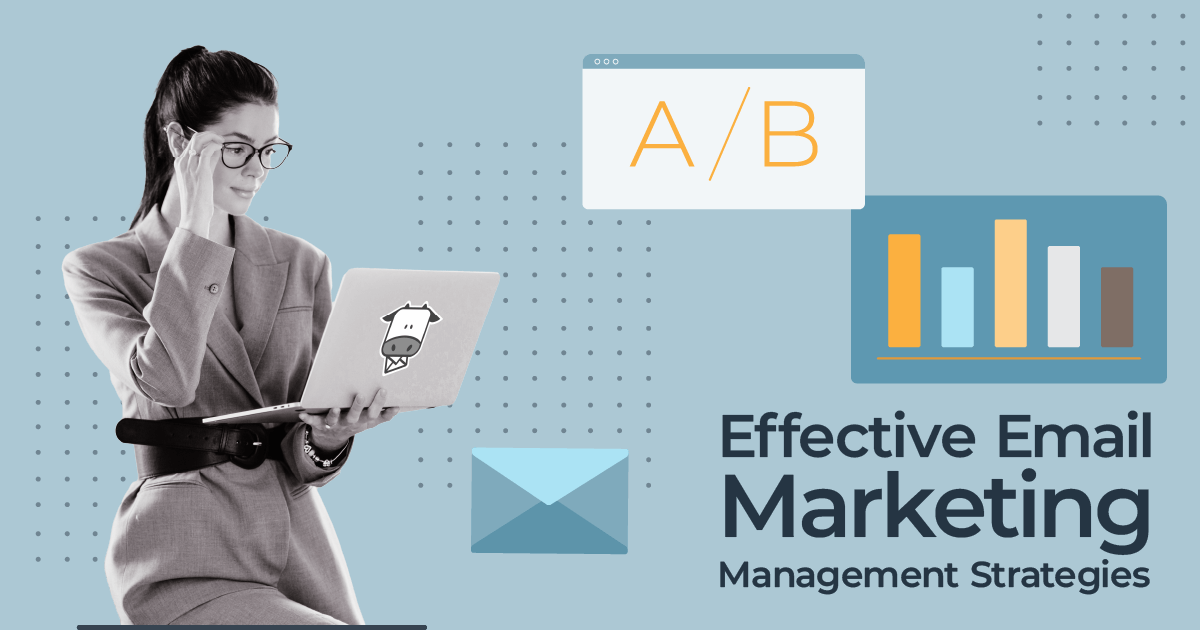
 Published by
Published by
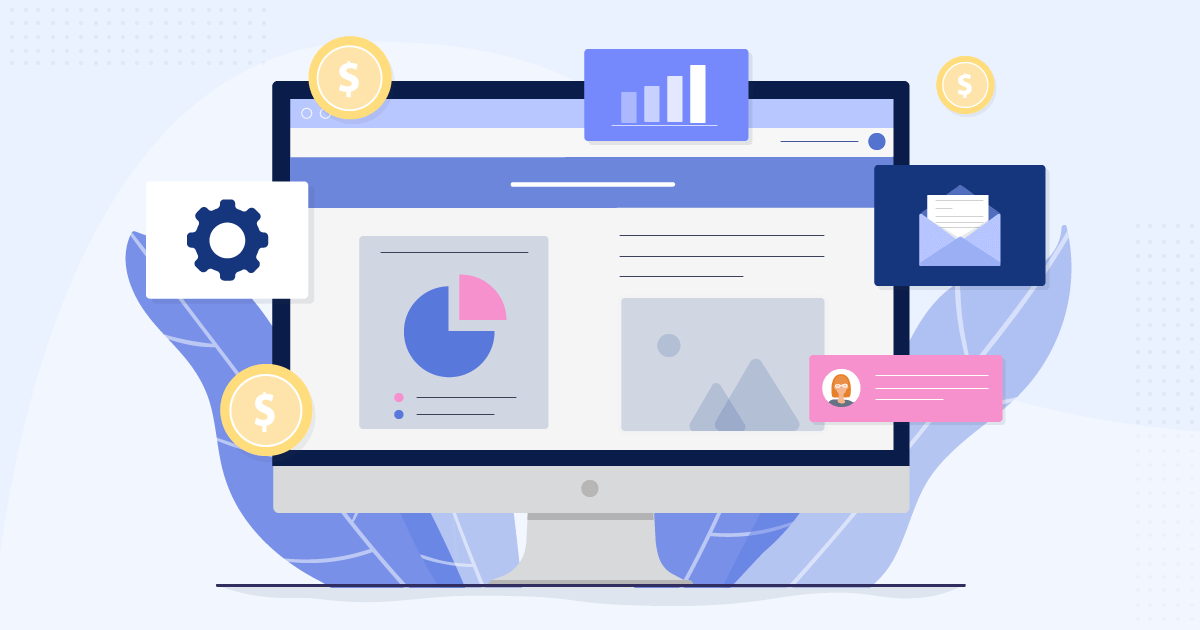
 Published by
Published by
